| Liverpool Cathedrals and Georgian Quarter |
|
|||||||
| Liverpool Cathedrals and Georgian Quarter |
|
|||||||
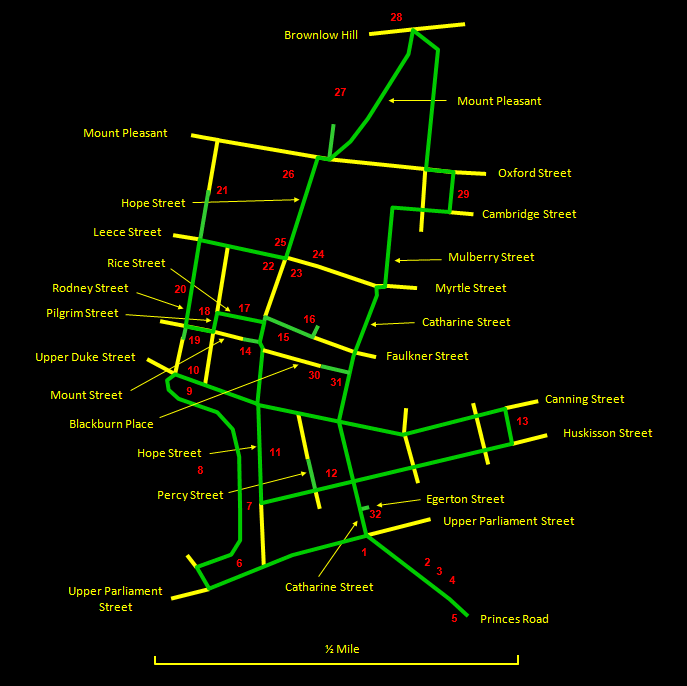 |
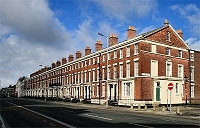 |
We start at the junction of Upper Parliament Street and Catherine Street/Princes Road. Upper Parliament Street (1807) was an extension of Parliament Street, the two marking the boundary between Liverpool and Toxteth Park. It has notably long and uniform terraces (c.1831 and later). Looking along Upper Parliament Street in either direction, we straight away get an idea of the kind of superb Georgian architecture we are to see on this walk. Opposite is the Greek Orthdox Church of St. Nicholas (1870) [1], an enlarged close copy of the former Church of St. Theodore in Istanbul, complete with four domes. We take a short detour along Princes Road to view a group of architecturally important buildings. First on the left is St. Margaret's Church (1869) [2], a simplified Gothic building with an attractive vicarage to one side. This was the main Roman Catholic church in Liverpool in the 19th century. | 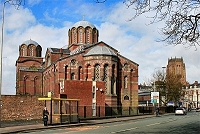 |
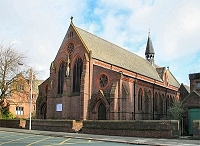 |
||
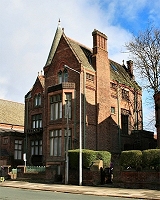 |
Next is Streatlam Tower (1871) [3], a large Gothic mansion with a conical tower. Next door is the Synagogue (1874) [4], according to the Pevsner Guide 'one of the finest examples of Orientalism in British synagogue architecture'. The style combines Gothic and Moorish elements. The interior is spectacular and occasionally open to general visitors. Further along on the opposite side is the Gothic Welsh Presbyterian Church (1868) [5], at the time it was built the tallest building in Liverpool but currently undergoing conversion. Its ambitious design reflected the growing prosperity of Liverpool's sizeable Welsh community. | 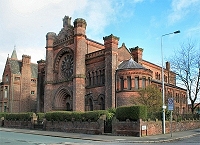 |
 |
||
 |
Retrace your steps to the Greek Orthodox Church and turn left down Upper Parliament Street. At Hope Street the Anglican Cathedral looms into view. Go along the southern edge of the cathedral site and then turn right to locate the entrance to St. James's Cemetery [6]. There was a stone quarry here in the 16th century and quarrying continued until the stone was exhausted in 1825. It was laid out as a cemetery in 1826 and closed in 1936. It was opened as a public park in 1972 after most of the gravestones and monuments had been relocated around the periphery. Descend into the park and follow the path through. Nowadays this is a shady and peaceful place from the depths of which the Cathedral [8] looks all the more imposing. You pass the Huskisson Mausoleum [7] marking the tomb of William Huskisson, Liverpool MP, who was killed by the locomotive Rocket on 15th September 1830, the opening day of the Liverpool and Manchester Railway. | 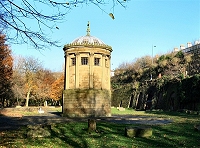 |
||
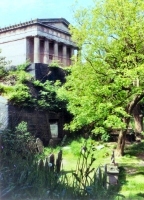 |
At the northern end of the park, you see the miniature Greek temple known as the Oratory (1829) [9] sitting on its acropolis. This once served as the chapel for St. James's Cemetery. It houses a collection of 19th century sculpture and funeral monuments and is occasionally open to the public. The exit from the cemetery here remains quite creepy. The dark and narrow path ascends through a tunnel and a deep cutting in the smoke-blackened sandstone rock, lined with gravestones. At the top is the Anglican Cathedral entrance. The building has a dominating presence on the Liverpool skyline as seen from all directions, near and far. The foundation stone was laid in 1904 but construction work using local sandstone was not completed, with many changes of design, until 1978. It is Britain's largest cathedral and the largest Anglican cathedral in the world. Access to the top of the tower is possible by a lift and many steps, the reward being sensational views over Liverpool and the surrounding country. If you have time, do go inside - you will not be disappointed. There is a nice little café overlooking the cemetery too. | 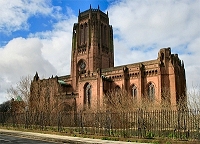 |
||
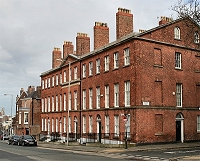 |
On leaving the cathedral precinct, turn right up Upper Duke Street. Opposite is Mornington Terrace [10], a very attractive group of red brick houses of c.1840. Turn right into Hope Street. Stretching all along the left-hand side of the road is Gambier Terrace [11], built at different times and to different designs. The first part (c.1830-c.1840) is a grand symmetrical structure with colonnades and balconies. The extension further along dates from the 1870s and is also symmetrical but in a completely different style and built of yellow brick. Along here you get one of the best views of the Cathedral. | 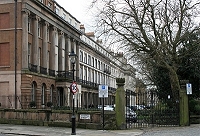 |
||
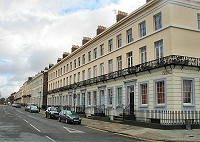 |
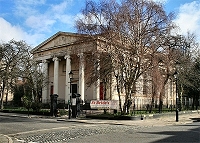 |
Turn left into Huskisson Street at a fine stuccoed terrace. On the corner with Percy Street is St. Bride's Church (1830) [12], built in the classical style, like a Greek temple with its monumental portico. Take a short detour into Percy Street, one of the finest in the area. The far end was one of the earliest housing developments. On the right is probably the grandest block in the quarter, a huge symmetrical design with a porch, colonnades and balconies. Opposite is a more restrained terrace in beautiful pink stone. | 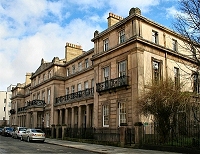 |
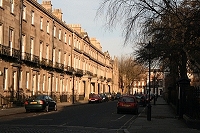 |
||
 |
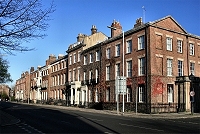 |
Return to Huskisson Street and, crossing Catherine Street, go along its entire length to Falkner Square [13]. On the way there are more elegant terraces. The stuccoed houses around the square were mostly completed by the early 1830s and the park was one of the city's first open public spaces. It is a lovely spot with mature trees, borders and grassy areas, and brings to mind squares in Georgian parts of London. | 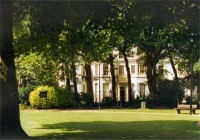 |
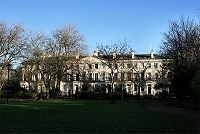 |
||
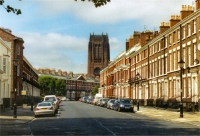 |
Walk through the gardens and then return along Canning Street, where there is a fine view of the cathedral tower rising above the houses. This is one of the longest and best-preserved residential streets in the Georgian Quarter. Continue across Catharine Street and turn right into Hope Street. A short way along on the left is Mount Street, at the top of which is a sculpture called A Case History representing a pile of luggage, with labels referring to local people and institutions. Hope Street famously runs between the two cathedrals. It was straightened in the 1790s and residential development began in earnest around 1800. | 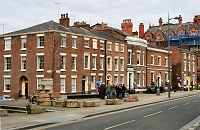 |
||
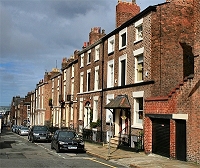 |
Take a short detour into Mount Street, where an attractive terrace of small town houses (c.1820) extends down the hill on the right. Opposite is the Liverpool Institute for Performing Arts or LIPA [14]. This plain but imposing building (1835-7) was originally the Mechanics' Institution and became the The Liverpool Institute High School for Boys in 1905. Among many famous pupils here were Beatles Paul McCartney and George Harrison. It reopened in 1996 as LIPA thanks to the efforts of McCartney and others. | 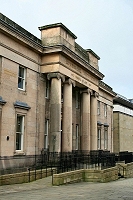 |
||
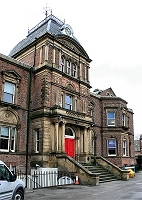 |
Return to Hope Street. In front of you is Blackburne House (c.1800) [15], built as a private residence and named after the owner. It later became the Liverpool Institute High School for Girls. The central tower, with a roof in the style of a French château, was added in 1874-6. Turn left along Hope Street, where there are some good eating places, and then turn right into Falkner Street. A short way along on the left, hidden in a little cul-de-sac, is the Belvedere [16], a little gem of a pub. It has survived unspoiled with a tiny bar and a not much bigger lounge served through a hatch in the hall. In the lounge is a drawing of John Lennon by one of his colleagues when he was a student at the Art School. | 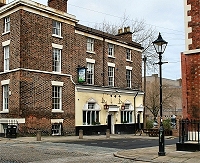 |
||
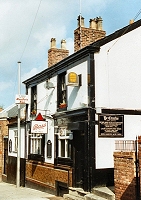 |
Return to Hope Street and go left and immediately right into narrow Rice Street, where you will find Ye Cracke [17], a characterful, no pretences pub and one of Liverpool's most famous. It was once the haunt of the student John Lennon and the Liverpool Poets. There is a tiny front bar and an even tinier snug known as the War Office, apparently because those who once wished to mull over the Boer War were banished there. There is also a large garish painting of a Napoleonic battle scene done in a primitive style. At the bottom of Rice Street, turn left into Pilgrim Street, where one of the old buildings is now an interesting and atmospheric pub, the Pilgrim [18], the entrance to which is tucked away in a little alley down some steps. The street has converted coach houses at the back of Rodney Street down one side that lend it a definite old world charm. Turn right into Mount Street and walk down to Rodney Street. |  |
||
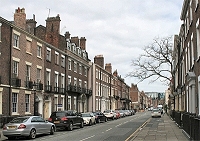 |
Rodney Street contains some of the finest Georgian architecture in the city. It is known for its numerous doctors' practices and has been dubbed the Harley Street of the North. It was laid out by William Roscoe and others in 1783-4 and was built in stages up to the 1820s by different architects, which accounts for the variety of frontages and roof-lines. A short way to the left along Rodney Street at No.59 [19] is the house and studio of photographer Edward Chambré Hardman. This is now owned by the National Trust and can be visited. It has been restored to what it must have been like when he lived and worked there from 1947 to 1988. It houses his studio, darkroom and living quarters, together with an extensive collection of his photographs and equipment. Turn around and head back along Rodney Street. On the left, No.62 (1792-3) was the birthplace of the famous Victorian politician William Ewart Gladstone. | 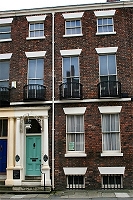 |
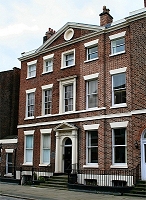 |
||
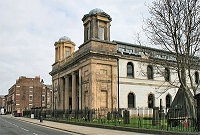 |
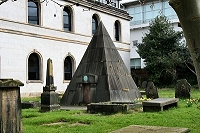 |
Continue along Rodney Street, across Hardman Street, to reach St. Andrew's Church (1824) [21], originally a Scottish Presbyterian church, on the right. This was recently in a sorry state, but was acquired by Liverpool John Moores University and heavily restored as student accomodation. The original churchyard remains, featuring a strange pyramid (1868), which is the tomb of railway magnate William Mackenzie, said to be buried in a seated position. Return to Hardman Street and turn left up the hill. On the right is the Old School for the Blind (1849-51) [22], which has recently been nicely refurbished as a restaurant and bar. | 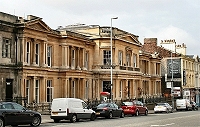 |
||
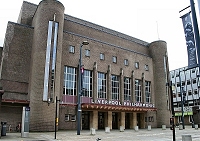 |
Continue up to the crossroads at Hope Street. On the opposite corner is the Philharmonic Hall (1939) [23]. The rather plain exterior holds within a virtual museum of Art Deco designs and it is, of course, the home of the wonderful Liverpool Philharmonic Orchestra. In front along Myrtle Street is the eye-cartching Eye and Ear Infirmary [24] in brilliant red brick, sandstone and terra cotta, now converted to flats. Its style is influenced by old English architecture, with timber-framed gables and tall chimneys, but on a massive scale. | 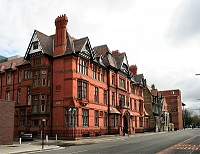 |
||
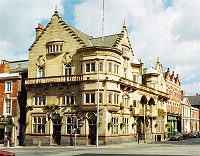 |
Turn left into Hope Street. On this corner is the Philharmonic Dining Rooms (1900) [25], probably Liverpool's most famous pub. The exterior is a kind of Scottish castle fantasy with magnificent art nouveau wrought iron gates. Inside, there is loving attention to detail with ornate plasterwork, stained glass windows, glazed tiles and mosiac floors. There are several large rooms lined with dark mahogany panelling and decorated with carving, the work of ships' carpenters who built the lavish interiors of the ocean-going liners of the time. The huge room at the back, the Grand Lounge, was once the billiards room. Two of the other rooms are called Brahms and Liszt (think music + alcohol). One of these has an imitation minstrel gallery, while in the other is a fine stained glass window dedicated to music. Perhaps the pub's most celebrated feature is the gents' toilet, an extravaganza in mosaic and marble. | 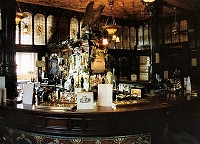 |
||
 |
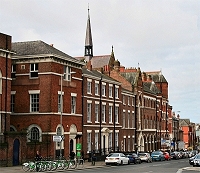 |
Continue along Hope Street, with the Roman Catholic Metropolitan Cathedral rising before you, to the junction with Mount Pleasant. On the right is the new Everyman Theatre. Opposite is Notre Dame Convent (originally 1851) [26], which is now part of Liverpool John Moores University. In front of you is the wonderful prospect of Liverpool Metropolitan Cathedral [27]. The original design was abandoned after completion of the crypt (1933-1958) and the present entirely different structure (1962-1967) was built on top, part of the crypt now serving as an elevated pedestrian platform with a fine view back along Hope Street to the Anglican Cathedral. The external structure, conical and crowned by a lantern tower and pinnacles, has resulted in its being known among scousers as Paddy's Wigwam or the Mersey Funnel. All is set off by the impressive entrance: a wide flight of steps with a bell tower above. The interior is breathtakingly beautiful in a way that catches the first-time visitor off-guard. You can sit among sympathetically modernist art-works with the sun flooding through intensely coloured glass. Do take a look inside, however briefly. | 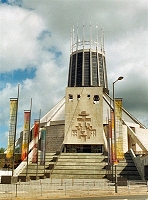 |
||
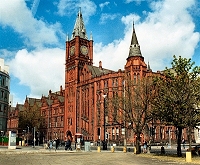 |
At the bottom of the Cathedral steps, where there is a good café, turn sharp left into Mount Pleasant. You are now heading into the Liverpool University campus. At the end on Brownlow Hill is the Victoria Building [28], the original college and the building responsible for the term Red-Brick University. It opened in 1892 with 45 students, compared with 32,000 today. In 1903, it received its charter and became the University of Liverpool. The Victoria Building is suitably imposing both outside and inside, though the interior tiling has always reminded me of the older style of public convenience. It houses a café and the Victoria Gallery and Museum. It fronts a collection of fine red-brick buildings of a similar vintage that are worth a detour if you feel so inclined. The remainder of the campus has some stylish new buildings and a hotch-potch of others of different vintages and interest value - I'll leave them to you. Turn sharp right, keeping to the left of the Students' Union Building and then bear right along the University's main pedestrian thoroughfare. |
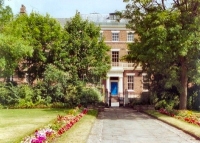 |
At the end we are back in the Georgian residential area at Abercromby Square [29]. This was the earliest residential area to be completed (c.1830). The east side, including the Greek temple styled St. Catharine's Church, was destroyed during World War II and the University now occupies all of the remaining buildings. The site of Abercromby Square and a large surrounding area was previously covered with an expanse of bog and water known as the Moss Lake. It is a pleasant spot to take a rest. Walk across to exit onto Cambridge Street and then go right down to Mulberry Street, where there is a pub called The Cambridge. Turn left along Mulberry Street to emerge onto Catharine Street. Go along Catherine Street past two pubs (The Caledonian and The Blackburne Arms). | ||
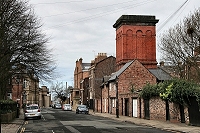 |
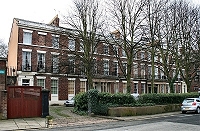 |
On the right past The Blackburne Arms is Blackburne Place, a characterful street sporting a prominent, red-brick ventillation tower (c.1890) that once served the Edge Hill to Wapping railway tunnel. Opposite it is the elegant and early Blackburne Terrace (1826) [30]. Back on Catherine Street is the Byzantine styled Roman Catholic church of St. Philip Neri (1920), with an attractive formal garden at the side. | 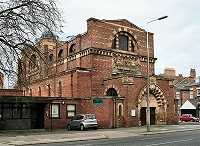 |
||
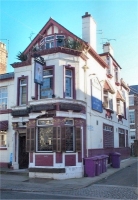 |
Carry on along Catherine Street, with fine Georgian architecture on both sides, until just before the start of the walk on the left is little Egerton Street. This is an unusual and charming street of two-storey terraces, with small, well-tended front gardens, dating from about 1844. At this stage of the walk, though, I would suggest that something more likely to be of interest would be Peter Kavanagh's, one of Liverpool's most interesting pubs (c.1870). The current building is the result of an extension of the 1970s into the two adjoining houses. The eponymous Mr. Kavanagh ran the pub for 53 years from 1897 and was responsible for designing the amazing interior, with its carved oak fittings and furniture. There is a mass of bric-a-brac, and stained glass windows depict Liverpool's shipping and railway connections; the round tables with spill channels apparently came from liners. But the wall paintings, dating from 1929 and depicting subjects from Dickens and Hogarth, are perhaps the most distinctive feature. Returning refreshed to Catherine Street, the bus stop for getting back into town is just in front of you. | ||